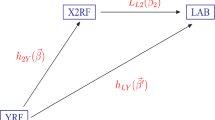Abstract
In this paper, we introduce the spinor helicity amplitude method. We provide the approaches to handle with massless fermions, massive spinors and polarization vectors respectively, then applied this method to some examples such as e + e −→μ + μ −, e − γ→e − γ, \(\bar {q}q \to gg\) processes. Among the examples, \(\bar {q}q\to gg\) process presented in the antecedent literatures, but we provide a more detailed calculation, and others are gave for the first time. We summarize all kinds of the situations, and give the needed formulas in appendix, which will be of use to collect these analysis formulas in one place.




Similar content being viewed by others
References
Dixon, L. J.: arXiv:hep-ph/1310.5353
Bjorken, J.D., Chen, M.C.: Phys. Rev. 154, 1335 (1966)
Reading-Henry, O.: Phys. Rev. 154, 1534 (1967)
De Causmaeker, P., Gastmans, R., Troost, W., Wu, T.T.: Phys. Lett. 105B, 215 (1981)
De Causmaeker, P., Gastmans, R., Troost, W., Wu, T.T.: Nucl. Phys. B206, 53 (1982)
Berends, F.A., Kleiss, R., De Causmaecker, P., Gastmans, R., Troost, W., Wu, T.T.: Nucl. Phys. B206, 61 (1982)
Dankaert, D., De Causmaecker, P., Gastmans, R., Troost, W., Wu, T.T.: Phys. Lett. 114BB, 203 (1982)
Berends, F.A., Kleiss, R., De Causmaecker, P., Gastmans, R., Troost, W., Wu, T.T.: Nucl. Phys. B239, 382 (1984)
Berends, F.A., Kleiss, R., De Causmaecker, P., Gastmans, R., Troost, W., Wu, T.T.: Nucl. Phys. B239, 395 (1984)
Berends, F.A., Kleiss, R., De Causmaecker, P., Gastmans, R., Troost, W., Wu, T.T.: Nucl. Phys. B264, 243 (1986)
Berends, F.A., Kleiss, R., De Causmaecker, P., Gastmans, R., Troost, W., Wu, T.T.: Nucl. Phys. B264, 265 (1986)
Dixon, L. J.: Boulder 1995, QCD and beyond, pp. 539–582. arXiv:hep-ph/9601359
Mangano, M. L., Parke, S. J.: Phys. Rept. 200, 301 (1991). arXiv:hep-th/0509223
Xu, Z., Zhang, D.-H., Chang, L.: Tsinghua University Preprints, Beijing, The People’s Republic of China, TUTP-84/4, TUTP-84/5, TUTP-84/6 and Nucl. Phys. B291, 392 (1987)
Gunion, J., Kunszt, Z.: Phys. Lett. 161B, 333 (1985)
Kleiss, R., Stirling, W. J.: Nucl. Phys. 262, 235 (1985)
Badger, S. D., Glover, E. W. N. , Khoze, V. V., Svrcek, P.: JHEP 0507, 025 (2005). arXiv:hep-th/0504159
Badger, S.D., Glover, E.W.N., Khoze, V.V.: JHEP 0601, 066 (2006). arXiv:hep-th/0507161
Xu, Z., Zhang, D.-H., Chang, L.: Tsinghua University Preprints TUTP–84/3, TUTP–84/4,and TUTP–84/5 Unpublished
Ozeren, K. J., Stirling, W. J.: Eur. Phys. J. C 48, 159 (2006). arXiv:hep-ph/0603071
Ellis, R.K., Stirling, W.J., Webber, B.R.: Camb. Monogr. Part. Phys. Nucl. Phys. Cosmol. 8, 1 (1996)
Kleiss, R., Stirling, W.J.: Phys. Lett. B 179, 159 (1986)
Bern, Z., Dixon, L.J., Kosower, D.A.: On-shell recurrence relations for one-loop QCD amplitudes. arXiv:hep-th/0501240
Bern, Z., Dixon, L.J., Kosower, D.A.: The last of the finite loop amplitudes in QCD. arXiv: hep-ph/0505055
Acknowledgments
This work was supported in part by the National Natural Science Foundation of China (No.11205003, No.11305001, No.11175001), the Key Research Foundation of Education Ministry of Anhui Province of China (No.KJ2012A021), the Youth Foundation of Anhui Province (No.1308085QA07), and financed by the 211 Project of Anhui University (No.02303319).
Author information
Authors and Affiliations
Corresponding author
Appendices
Appendix A: Polarization Vectors and Spinor Properties
We will use notations and conventions as in [14], and will summarize them here for ease of reference. Let ψ(p) be a massless Dirac spinor. We will denote its chiral projections as follows:
By convention, we will choose the spinor phases so as to satisfy the following identities:
where the suffix c stands for the charge conjugation operation:
We will also introduce the following notation:
The spinors are normalized as follows:
From the properties of the Dirac algebra, it is straightforward to prove the following useful identities:
In the identity (A.11) the possibility of having spinors with energies of different sign is considered. This will be important in the following, since for simplicity we will always carry out the calculations of the matrix elements assuming all of the particles as being outgoing. Energy-momentum conservation will then force the energy of some of the particles to be negative.
Notice that the following equations hold for generic chiral spinors (not necessarily solutions of a Dirac equation) which satisfy (A.2): (A.9), (A.10), (A.13), (A.14), (A.15), (A.16).
The polarizations for vectors with momentum p, as defined in the text:
enjoy the following properties:
Appendix B: Notation and Conventions with Massive Spinors
We have used products of Dirac spinors
with massive p i ,p j . To evaluate these we use two arbitrary four vectors k 0 and k 1, such that
Then
where m i is negative if i is an antiparticle. Different choices of k 0 correspond to different choices of the quantization axis of a massive fermion’s spin, as described in Section 2.
We use the notation


Whereas for massless vectors k i ,k j we have the familiar relation 2k i ⋅k j =〈i j〉 [j i], in the massive case this is extended to
For any massive i,j and massless k,l we have

The Schouten identity holds,
For gluon polarization vectors we use
which take the slashed form


We use a shorthand form for the amplitude in which we display only the helicities of the particles involved. So for example,
Rights and permissions
About this article
Cite this article
Niu, L., Mao, S., Gang, L. et al. Spinor Helicity Amplitudes Method. Int J Theor Phys 54, 2813–2829 (2015). https://doi.org/10.1007/s10773-015-2518-1
Received:
Accepted:
Published:
Issue Date:
DOI: https://doi.org/10.1007/s10773-015-2518-1




